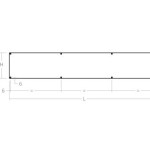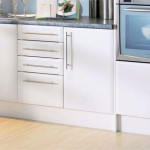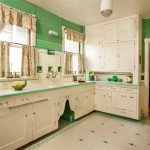Kitchen Cupboard Door Chip Repair: A Comprehensive Guide
Kitchen cupboard doors, subjected to daily use and occasional impacts, are prone to chipping. These chips, while often small, can detract from the overall aesthetic of the kitchen space. Addressing these imperfections promptly not only improves the appearance of the cabinetry but also prevents further damage, such as water intrusion and peeling of the finish.
This article provides a detailed guide to repairing chips in kitchen cupboard doors, covering various repair methods suitable for different materials and severity of damage. The information presented aims to equip individuals with the knowledge necessary to undertake effective and lasting repairs, restoring the integrity and visual appeal of their kitchen cupboards.
Identifying the Material and Damage
Before commencing any repair, accurately identifying the type of material the cupboard door is made of is crucial. Common materials include solid wood (such as oak, maple, or pine), wood veneer over particleboard or MDF (Medium-Density Fiberboard), laminate, and painted surfaces. Each material requires a specific approach and suitable repair products.
The severity of the chip also dictates the appropriate repair strategy. Minor surface chips affecting only the finish may require a different approach than larger chips that penetrate the underlying material. Evaluating the size, depth, and location of the chip is a necessary first step.
For example, a small chip in a solid wood door can often be addressed with wood filler and touch-up paint. A chip in the laminate, however, may require a specialized laminate repair kit. Ignoring the material composition can lead to ineffective repairs or even further damage to the door.
Repairing Chips in Solid Wood Cupboard Doors
Solid wood cupboard doors offer a relatively straightforward repair process due to the inherent workability of the material. The primary goal is to fill the chipped area and blend the repair seamlessly with the surrounding wood.
The first step involves cleaning the chipped area thoroughly. Remove any loose fragments of wood or finish with a small brush or vacuum cleaner. Ensure the area is free of dust, grease, or other contaminants that could interfere with the adhesion of the repair material. Lightly sanding the edges of the chip can help create a smooth transition between the damaged area and the undamaged surface.
Next, apply a wood filler appropriate for the specific wood species. Choose a filler that is stainable and paintable to achieve the desired finish. Use a putty knife to press the filler firmly into the chipped area, ensuring it fills the void completely. Overfill slightly, as the filler will shrink as it dries. Allow the filler to dry completely according to the manufacturer's instructions. Drying times can vary depending on the type of filler and environmental conditions.
Once the filler is dry, sand it smooth with fine-grit sandpaper (typically 220-grit or higher). Begin with a slightly coarser grit if necessary to remove excess filler, then gradually move to finer grits to achieve a smooth, even surface. Feather the edges of the repair to blend it seamlessly with the surrounding wood. Be careful not to sand away too much of the adjacent finish.
After sanding, clean the area again to remove any sanding dust. Apply a primer specifically designed for wood. This will help the paint or stain adhere properly and provide a uniform base color. Allow the primer to dry completely.
Finally, apply a matching paint or stain to the repaired area. If using paint, apply thin, even coats, allowing each coat to dry completely before applying the next. Multiple thin coats are preferable to one thick coat, which can lead to runs or drips. If using stain, apply it evenly with a brush or cloth, then wipe off the excess. Matching the stain color may require some experimentation; test different stain colors on a scrap piece of wood or in an inconspicuous area of the cupboard door before applying it to the repaired area.
Apply a topcoat or sealant to protect the repaired area and provide a durable finish. Choose a topcoat that matches the sheen of the existing finish (e.g., matte, satin, or gloss). Allow the topcoat to dry completely.
Repairing Chips in Laminate Cupboard Doors
Laminate cupboard doors present a different set of challenges compared to solid wood. Laminate is a thin layer of plastic bonded to a substrate, typically particleboard or MDF. Chips in laminate often expose the underlying substrate, which is more susceptible to moisture damage.
The repair of laminate chips typically involves using a laminate repair kit, which contains a color-matched filler or putty specifically designed for repairing laminate surfaces. These kits often include a heat tool or soldering iron to melt the filler and bond it to the laminate.
As with solid wood repairs, begin by cleaning the chipped area thoroughly. Remove any loose fragments of laminate or substrate. Ensure the area is free of dust, grease, or other contaminants. Lightly sanding the edges of the chip can help create a smooth transition.
Apply the laminate repair filler to the chipped area. Follow the instructions provided with the repair kit, as different kits may have different application methods. Some kits require heating the filler with a specialized tool, while others use a cold-setting putty. Ensure the filler completely fills the void and is slightly overfilled to compensate for shrinkage.
If using a heat tool, carefully melt the filler into the chipped area, ensuring it bonds to the laminate and the exposed substrate. Avoid overheating the laminate, as this can cause it to warp or peel. Use a clean cloth or applicator to smooth the filler and remove any excess.
Allow the filler to cool and harden completely. This may take several hours, depending on the type of filler and the ambient temperature.
Once the filler is hardened, carefully sand it smooth with fine-grit sandpaper. Feather the edges of the repair to blend it seamlessly with the surrounding laminate. Be extremely cautious when sanding, as laminate is easily scratched. Use light pressure and avoid sanding the surrounding undamaged laminate.
Clean the area again to remove any sanding dust. If necessary, apply a laminate touch-up paint or stain to further blend the repair with the surrounding laminate. Choose a color that closely matches the existing laminate. Apply thin, even coats, allowing each coat to dry completely.
Some laminate repair kits include a clear topcoat or sealant to protect the repaired area. Apply this topcoat according to the manufacturer's instructions.
Repairing Chips in Painted Cupboard Doors
Painted cupboard doors, regardless of the underlying material (solid wood, veneer, or MDF), require a slightly different approach to chip repair. The primary focus is on replicating the existing paint finish and achieving a seamless color match.
Begin by cleaning the chipped area thoroughly. Remove any loose fragments of paint or underlying material. Ensure the area is free of dust, grease, or other contaminants. Lightly sanding the edges of the chip can help create a smooth transition.
If the chip exposes the underlying material (e.g., wood or MDF), apply a primer specifically designed for that material. This will help the paint adhere properly and prevent moisture from damaging the substrate. Allow the primer to dry completely.
Apply a paintable wood filler to the chipped area, if needed, to level the surface. Allow it dry completely according to the manufacturer's instructions, then sand smooth with fine-grit sandpaper. Clean the area after sanding.
The most critical step is matching the existing paint color. If the original paint is available, use it for the repair. If not, take a sample of the cupboard door to a paint store and have them color-match the paint using a spectrophotometer. It is essential to specify the type of paint (e.g., latex, acrylic, oil-based) and the sheen (e.g., matte, satin, semi-gloss, gloss).
Apply thin, even coats of the matched paint to the repaired area, allowing each coat to dry completely before applying the next. Multiple thin coats are preferable to one thick coat. Feather the edges of the repair to blend it seamlessly with the surrounding paint. Use a high-quality brush or a small foam roller to achieve a smooth, even finish.
Consider using a clear topcoat to protect the repaired area and provide a more durable finish, especially in high-traffic areas. Choose a topcoat with a sheen that matches the existing paint finish.
For small chips, a touch-up paint pen can be a convenient solution. These pens contain a small amount of paint and a fine-tipped applicator, allowing for precise application to tiny chips and scratches. However, color matching can be challenging, and the finish may not be as durable as a properly applied paint job.

How To Repair Cabinets The Fast And Easy Way

How To Repair Cabinets The Fast And Easy Way

How Do I Fix Chipped Damaged Cabinet Frame Corner Hometalk

How Do I Fix Laminate Cabinets Hometalk

Scratched And Chipped Kitchen Cabinet Doors Refinishing Touch

My Laminate Drawers And Doors Are Ling Ing Help Hometalk

Scratched And Chipped Kitchen Cabinet Doors Refinishing Touch

How Do I Repair The Edges On My Laminate Cupboards Hometalk

Cabinet Door Finish Failure Diagnosis And Repair

How To Touch Up Chipped Cabinets With A Paint Pen Exquisitely Unremarkable
Related Posts








